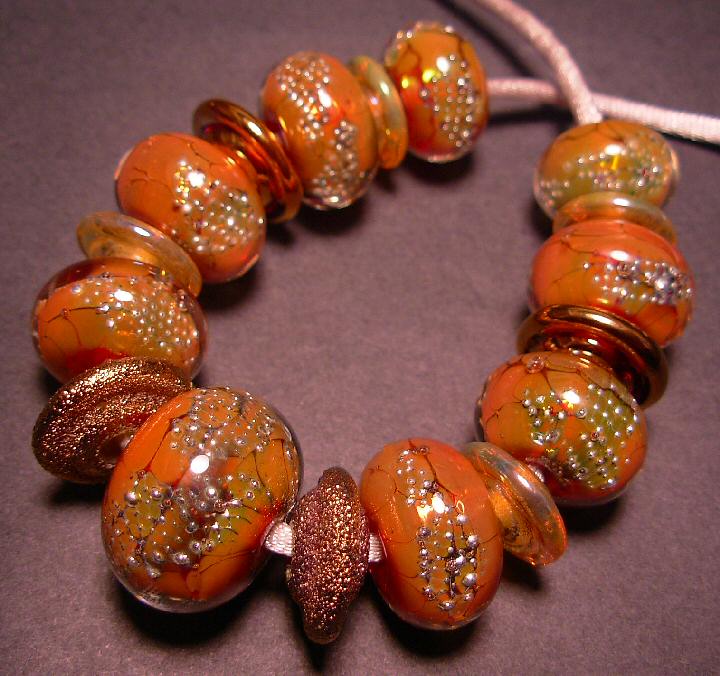What is Effetre (Soft Glass)?
| There are two categories of Lampwork glass; Soft glass and Hard glass. | |
| Effetre (soft glass)...is a soda lime based glass and is called soft because it has a lower melting temperature, holds heat longer, has a longer working time when removed from the flame and is softer and easier to manipulate. Moretti, Murano, Lausha, Bullseye, Satake and P.I.G. are all soft glasses. Borosilicate (hard glass) is a boron based glass and is called hard because it has a higher melting temperature, does not hold heat very long, has a short working time when removed from the flame and is stiffer than soft glass. Glass Alchemy, Northstar, Colormax, Momka, Duran and Pyrex are all hard glasses. | |
| Where does Effetre glass come from? The glasses we use are popular and widely distributed composites known as Moretti, Lauscha and Murano glass. Moretti and Murano are manufactured in Venice, Italy on the island of Murano and Lauscha is manufatured in Lauscha, Germany. Effetre Glass is provided to lampwork artists in the shape of glass rods. The rods are easily spun in the flame which helps evenly distribute the heat. The Effetre company and the island of Murano shares a long traditon of Venitian glass manufacturing. The island has been officially designated as an industrial center for glass work since 1291 AD. A close relationship between Artists, Glass Manufacturers, and Merchants has enabled Venice to serve as a world leader in the glass arts since the 1500's. Many of the reciepes, processes, and raw materials used to create Effetre glass rods are closely guarded secrets handed down over generations. The color in beads made from Murano glass of the 16th century is as bright today as when the beads were made. It is nice to know the beads you see today will be bright and clear in the future as well. A benifit to todays artists is the freedom that years of testing and refinement provide as more combinations of color and style are possible than than ever before. Lampwork artists throughout the world continue a great Venitian glass working tradition when they choose soft glass. |
|
 24kt. Galaxies Murano Glass by Krista Tseu (5FishDesigns) |
|
| Annealing...is the process of slowly reducing the temperature of the hot glass. The annealing process makes glass beads very strong and durable. Beads that have not been annealed will have "stress" in them, which means that on a molecular level, the glass is unstable, and outside forces (falling on the ground, temperature, pressure, etc.) can cause them to develop cracks, stress fractures, or even break. In order to relieve this stress, the bead is held at a very precise temperature range for specified periods of time in the kiln. We use a kiln "controller" which starts the beads out at about 1,050 degrees and slowly ramps down by 100 degrees per hour until the bead is brought to room temperature. When a bead is taken out of the kiln it is still on the stainless steel mandrel. Before removal, the cooled bead is then soaked in water to soften the bead release agent. Once the bead is removed from the mandrel the holes are cleaned and filed with a Dremel diamond file. They are then ready to become gorgeous jewelry to bring years of happiness. | |
| Do glass beads really last for centuries?
Yes! Glass beads are known to last for hundreds, even thousands of years. A remarkable characteristic of glass is that it retains color better than almost any other art material. The soft glass we use has been manufactured in Murano, Italy for centuries and is proven to hold finish, lustre, and color with no special storage requirements. Oil paintings and antique metal works are far more fragile.
The round shape of most beads is inherently strong, however we take an additional step to strengthen our beads by annealling them in a kiln. The annealing process involves reheating the bead slowly and keeping it hot in a near molten state long enough for any tension or stress, trapped as the bead was formed, to self-adjust and even out. The beads are cooled very slowly, and the annealling process takes about 5 hours but the beads become much stronger. The beads we offer are hand made and computer/kiln annealled, with the intention of providing years of satifaction and hierloom quality. |
|
| Another wonderful source of information about the Art of Lampwork Glass Beadmaking can be found at the International Society of Glass Beadmakers website. | |
